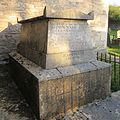John Nash (architect)
John Nash (18 January 1752 – 13 May 1835) was an English architect responsible for much of the layout of Regency London. He was the most important architect of the period 1800 to 1835
| John Nash | |
 | |
| Personal information | |
|---|---|
| Name | John Nash |
| Nationality | English |
| Birth date | 18 January 1752 |
| Birth place | Lambeth |
| Date of death | 13 May 1835 |
| Place of death | Isle of Wight |
| Work | |
| Buildings | Royal Pavilion Buckingham Palace |
Life
Nash was born in Lambeth. He studied architecture as an apprentice to Sir Robert Taylor for nine years.[1]
From 1810, Nash would take very few private commissions. He was a dedicated Whig and was a friend of Charles James Fox, who was Foreign Secretary in 1806. Perhaps through Fox, Nash came to the attention of the Prince Regent (later King George IV). For the rest of his career he would largely work for the Prince. His first major commissions in 1811 from the Prince was Regent Street and the development of an area then known as Marylebone Park.
With the Regent's backing Nash created a master plan for the area, put into action from 1818 onwards, which stretched from St James’s northwards and included Regent Street, Regent's Park and its neighbouring streets, terraces and crescents of elegant town houses and villas. Nash did not complete all the detailed designs himself; in some instances, completion was left in the hands of other architects. Nash was employed by the Prince to develop his Ocean Pavilion Palace in Brighton, originally designed by Henry Holland. By 1822 Nash had finished his work on the Ocean Pavilion, which was now transformed into the Royal Pavilion.
His works
Examples of his work include:
London
- Buckingham Palace: the state rooms and western front
- Regent Street
- Regent's Park
- Park Square
- Park Crescent
- Regent's Canal
- Carlton House Terrace, London
- St James Park
- Marble Arch
- Haymarket Theatre
- Clarence House
- Cumberland Terrace
- Trafalgar Square (first version)
- The Royal Mews
England & Wales
- Cardigan Gaol
- The Brighton Royal Pavilion
- Luscombe Castle
- Sandridge Park
- Guildhall, Newport, Isle of Wight
- Castle House, later extended to form Old College Aberystwyth University
- Hereford Gaol
- Whitson Court, near Newport
- Sandridge Park
- Caerhays Castle, Cornwall
- Ravensworth Castle
John Pattisons house. Newport iow
Ireland
- Ballindoon House
- Killymoon Castle, near Cookstown, County Tyrone
- Shanbally Castle, near Clogheen, South Tipperary
- Rockingham House, Boyle, County Roscommon
- Lough Cutra Castle, County Galway
John Nash (architect) Media
Cronkhill, Shropshire - one of Nash's earlier buildings and the first "Italianate villa in England"
Gates to Clytha Park, Monmouthshire
Diamond Cottage, Blaise Hamlet
The Royal Pavilion, Brighton
West front of Buckingham Palace
Lake in St James's Park
Nash's tomb at St James's Church, East Cowes
References
| Wikimedia Commons has media related to Lua error in Module:Commons_link at line 62: attempt to index field 'wikibase' (a nil value).. |
- ↑ Tyack, Geoffrey (Ed) (2013) John Nash Architect of the Picturesque, English Heritage, p. 3. ISBN 978-1848-021020









